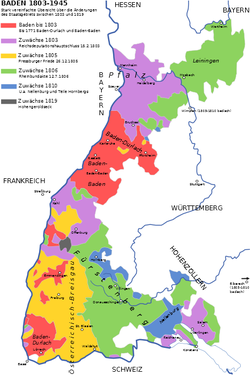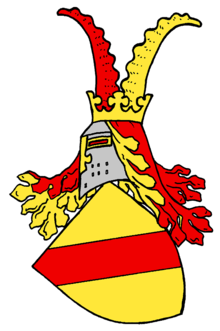User:JuFra35/House of Baden
House of Baden[edit]

Margraviate of Baden Markgrafschaft Baden (German) | |||||||||
|---|---|---|---|---|---|---|---|---|---|
| 1112–1803 | |||||||||
 Baden until 1803 (red) and later gains | |||||||||
| Status | Margraviate | ||||||||
| Capital |
| ||||||||
| Government | Feudal monarchy | ||||||||
| Margrave of Baden | |||||||||
• 1112–1130 | Herman II | ||||||||
• 1250–1268 | Frederick I | ||||||||
• 1453–1458 | Bernard II | ||||||||
• 1475–1515 | Christopher I | ||||||||
• 1771–1803 | Charles Frederick | ||||||||
| History | |||||||||
• Margraviate est. | 1112 | ||||||||
• Territory partitioned b | 1190–1771 | ||||||||
• Elevated to Electorate | 1803 | ||||||||
| |||||||||
| Today part of | Germany | ||||||||
a: Charles Frederick was the Margrave of Baden-Durlach until 1771, when he inherited Baden-Baden and became the margrave of unified Baden. In 1803, his support of Napoleon rewarded him with the rank of prince-elector. In 1806, he was raised to the rank of Grand Duke, when he joined the Confederation of the Rhine. b: Baden was partitioned in the years between 1190–1503, 1515–1620 and 1622–1771. | |||||||||
The House of Baden has been part of the German high nobility for centuries. The noble family's roots lie in the regions of Breisgau, Ortenau, Baar, Hegau, and Thurgau. Already in the High Middle Ages, the common ancestors of House of Zähringen and the later House of Baden held county rights in these regions, making them one of the most significant families in the southwest of the Duchy of Swabia.
History[edit]
The founder of the house was Hermann I, the eldest son of Duke Berthold I of Carinthia. Hermann II, son of Hermann I, was Count in Breisgau and the first to adopt the name 'von Baden' after the castle Hohenbaden in 1112. He gained control of the Baden-Baden region through a settlement between the Zähringers and the Staufen over the Duchy of Swabia. In 1112, he assumed the margrave title inherited from his father, originally associated with the Margraviate of Verona, thereby establishing the new Margraviate of Baden.
Territorial expansions followed: The original territory along the middle Neckar around Backnang and Besigheim, along with newly acquired areas in the Upper Rhine, were connected in 1219 through the acquisition of Pforzheim. In 1442, these territories were connected to the Breisgau holdings through shares of the lordships of Lahr and Mahlberg. From 1190, a branch known as the Hachberg line emerged. Their lands were repurchased in 1415 by Margrave Bernhard I, although without the sovereignty over Sausenberg, which only passed back to the main Baden line in 1503.
In 1535, the Margraviates of Baden-Baden and Baden-Durlach emerged through inheritance division from the Margraviate of Baden. Margrave Charles Frederick of Baden-Durlach inherited the Catholic branch of Baden-Baden in 1771, reuniting both margraviates. The residence was established in Karlsruhe, where a new Baroque capital city had been developing near Durlach Castle since 1715. Towards the end of the Holy Roman Empire, he first became Elector and later, following the Empire's dissolution in 1806, Grand Duke.
From 1830 onward, the morganatic branch (descended from Luise Karoline von Hochberg) assumed the title of Grand Duke. Their ascension to power was overshadowed by rumors at the time suggesting Kaspar Hauser was the son of the late Grand Duke Karl, who passed away in 1818, thus making him the rightful heir to the throne. The inheritance rights of the Hochberg branch had been internationally recognized as early as 1818 during the Congress of Aachen. This lineage played a significant role in both the formation of the German Empire, with Grand Duke Friedrich I being the first to proclaim "Long live Emperor Wilhelm" in the Hall of Mirrors at Versailles, and in the dissolution of the German Empire in 1918, when Chancellor Maximilian von Baden announced the abdication of Emperor Wilhelm II on November 9.
After the abolition of the monarchy[edit]
On November 22, 1918, during the November Revolution, the last Grand Duke of Baden abdicated. Thereafter, as the head of the House of Baden, he bore the title Margrave of Baden. The newly established Republic of Baden took possession of Karlsruhe Palace, along with the castles in Rastatt, Mannheim, Schwetzingen, and Bruchsal, placing them under state ownership. In a settlement agreement, the House of Baden retained ownership of the castles in Baden-Baden and Salem, along with their art treasures. Due to Grand Duke Friedrich II and Hilda having no male heirs, they adopted their great-nephew, Berthold von Baden. To settle substantial debts incurred much later, Margrave Max von Baden sold Eberstein Castle in Gernsbach in 2000. Additionally, following an auction of its art treasures, he sold the New Castle in Baden-Baden to an investor from Kuwait in 2003. The Salem Castle was taken over by the state of Baden-Württemberg in 2009, although the family retained the right to reside in one wing. In 2006, an attempt by Prince Bernhard of Baden and the state government of Baden-Württemberg under Günther Oettinger to finance the castle's renovation by selling cultural assets from the Baden State Library caused controversy. This incident, known as the Karlsruhe Cultural Asset Affair, sparked intense debates in the Baden-Württemberg State Parliament.
Coat of Arms[edit]

The original coat of arms (Zähringen) displays a red diagonal right-hand bar on a gold background. Above the helmet, adorned with red and gold helmet covers, are a red and a golden ibex horn.


